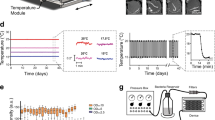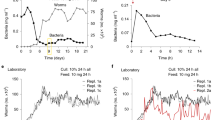Abstract
When both genotype and environment are held constant, 'chance' variation in the lifespan of individuals in a population is still quite large. Using isogenic populations of the nematode Caenorhabditis elegans, we show that, on the first day of adult life, chance variation in the level of induction of a green fluorescent protein (GFP) reporter coupled to a promoter from the gene hsp-16.2 predicts as much as a fourfold variation in subsequent survival. The same reporter is also a predictor of ability to withstand a subsequent lethal thermal stress. The level of induction of GFP is not heritable, and GFP expression levels in other reporter constructs are not associated with differences in longevity. HSP-16.2 itself is probably not responsible for the observed differences in survival but instead probably reflects a hidden, heterogeneous, but now quantifiable, physiological state that dictates the ability of an organism to deal with the rigors of living.
This is a preview of subscription content, access via your institution
Access options
Subscribe to this journal
Receive 12 print issues and online access
$209.00 per year
only $17.42 per issue
Buy this article
- Purchase on Springer Link
- Instant access to full article PDF
Prices may be subject to local taxes which are calculated during checkout



Similar content being viewed by others
Accession codes
References
Finch, C.E. & Kirkwood, T.B. Chance, Development and Aging (Oxford University Press, London, 2000).
Kirkwood, T.B. & Finch, C.E. Ageing: the old worm turns more slowly. Nature 419, 794–795 (2002).
Finch, C.E. & Tanzi, R.E. Genetics of aging. Science 278, 407–411 (1997).
Johnson, T.E. Increased life-span of age-1 mutants in Caenorhabditis elegans and lower Gompertz rate of aging. Science 249, 908–912 (1990).
Johnson, T.E. et al. Gerontogenes mediate health and longevity in nematodes through increasing resistance to environmental toxins and stressors. Exp. Gerontol. 35, 687–694 (2000).
Vaupel, J.W. et al. Biodemographic trajectories of longevity. Science 280, 855–860 (1998).
Kenyon, C. Ponce d'elegans: genetic quest for the fountain of youth. Cell 84, 501–504 (1996).
Link, C.D., Cypser, J.R., Johnson, C.J. & Johnson, T.E. Direct observation of stress response in Caenorhabditis elegans using a reporter transgene. Cell Stress Chaperones 4, 235–242 (1999).
Cypser, J.R. & Johnson, T.E. Multiple stressors in Caenorhabditis elegans induce stress hormesis and extended longevity. J. Gerontol. A Biol. Sci. Med. Sci. 57, B109–B114 (2002).
Calabrese, E.J. & Baldwin, L.A. Defining hormesis. Hum. Exp. Toxicol. 21, 91–97 (2002).
Lithgow, G.J., White, T.M., Melov, S. & Johnson, T.E. Thermotolerance and extended life-span conferred by single-gene mutations and induced by thermal stress. Proc. Natl. Acad. Sci. USA 92, 7540–7544 (1995).
Kelly, W.G., Xu, S., Montgomery, M.K. & Fire, A. Distinct requirements for somatic and germline expression of a generally expressed Caernorhabditis elegans gene. Genetics 146, 227–238 (1997).
Elowitz, M.B., Levine, A.J., Siggia, E.D. & Swain, P.S. Stochastic gene expression in a single cell. Science 297, 1183–1186 (2002).
Raser, J.M. & O'Shea, E.K. Control of stochasticity in eukaryotic gene expression. Science 304, 1811–1814 (2004).
Brenner, S. The genetics of Caenorhabditis elegans. Genetics 77, 71–94 (1974).
Johnson, T.E. & Wood, W.B. Genetic analysis of life-span in Caenorhabditis elegans. Proc. Natl. Acad. Sci. USA 79, 6603–6607 (1982).
Herskind, A.M. et al. The heritability of human longevity: a population-based study of 2872 Danish twin pairs born 1870–1900. Hum. Genet. 97, 319–323 (1996).
Gillooly, J.F., Brown, J.H., West, G.B., Savage, V.M. & Charnov, E.L. Effects of size and temperature on metabolic rate. Science 293, 2248–2251 (2001).
McAdams, H.H. & Arkin, A. It's a noisy business! Genetic regulation at the nanomolar scale. Trends Genet. 15, 65–69 (1999).
Strehler, B.L. & Mildivan, A.S. General theory of mortality and aging. Science 132, 14–21 (1960).
Kirkwood, T.B. et al. What accounts for the wide variation in life span of genetically identical organisms reared in a constant environment? Mech. Ageing Dev. 126, 439–443 (2005).
Melov, S., Lithgow, G.J., Fischer, D.R., Tedesco, P.M. & Johnson, T.E. Increased frequency of deletions in the mitochondrial genome with age of Caenorhabditis elegans. Nucleic Acids Res. 23, 1419–1425 (1995).
Golden, T.R. & Melov, S. Microarray analysis of gene expression with age in individual nematodes. Aging Cell 3, 111–124 (2004).
Herndon, L.A. et al. Stochastic and genetic factors influence tissue-specific decline in ageing C. elegans. Nature 419, 808–814 (2002).
Fedoroff, N. & Fontana, W. Genetic networks. Small numbers of big molecules. Science 297, 1129–1131 (2002).
Klass, M.R. Aging in the nematode Caenorhabditis elegans: major biological and environmental factors influencing life span. Mech. Ageing Dev. 6, 413–429 (1977).
Rao, C.V., Wolf, D.M. & Arkin, A.P. Control, exploitation and tolerance of intracellular noise. Nature 420, 231–237 (2002).
Baker, G.T. III & Sprott, R.L. Biomarkers of aging. Exp. Gerontol. 23, 223–239 (1988).
Walker, G.A. & Lithgow, G.J. Lifespan extension in C. elegans by a molecular chaperone dependent upon insulin-like signals. Aging Cell 2, 131–139 (2003).
Acknowledgements
We thank members of the laboratory of T.E.J., especially C. Link and S. Henderson, for comments and support; G. Amdam for insight into control theory; and A. Smith for help. Support for this work was provided by the US National Institutes of Health (to J.W.V. and to T.E.J.) and by a Polis Foundation Grant (to S.L.R.).
Author information
Authors and Affiliations
Corresponding author
Ethics declarations
Competing interests
The authors declare no competing financial interests.
Supplementary information
Supplementary Fig. 1
Western analysis. (PDF 766 kb)
Supplementary Fig. 2
HSP-16::GFP expression in individual worms. (PDF 833 kb)
Supplementary Fig. 3
Differential expression of MTL-2::GFP. (PDF 638 kb)
Supplementary Table 1
Mean lifespan — selected longevity. (PDF 9 kb)
Supplementary Table 2
Mean lifespan — all longevity. (PDF 9 kb)
Supplementary Table 3
Mean survival. (PDF 7 kb)
Supplementary Table 4
P value for log rank test. (PDF 5 kb)
Rights and permissions
About this article
Cite this article
Rea, S., Wu, D., Cypser, J. et al. A stress-sensitive reporter predicts longevity in isogenic populations of Caenorhabditis elegans. Nat Genet 37, 894–898 (2005). https://doi.org/10.1038/ng1608
Received:
Accepted:
Published:
Issue Date:
DOI: https://doi.org/10.1038/ng1608
This article is cited by
-
Damage dynamics and the role of chance in the timing of E. coli cell death
Nature Communications (2023)
-
Using single-worm RNA sequencing to study C. elegans responses to pathogen infection
BMC Genomics (2022)
-
Fatty acids derived from the probiotic Lacticaseibacillus rhamnosus HA-114 suppress age-dependent neurodegeneration
Communications Biology (2022)
-
Capsaicinoid-Glucosides of Fresh Hot Pepper Promotes Stress Resistance and Longevity in Caenorhabditis elegans
Plant Foods for Human Nutrition (2022)
-
Saturated very long chain fatty acid configures glycosphingolipid for lysosome homeostasis in long-lived C. elegans
Nature Communications (2021)



